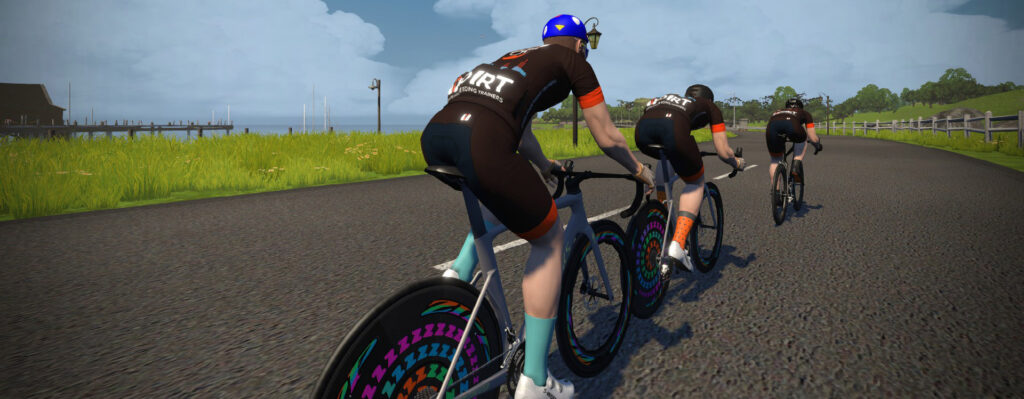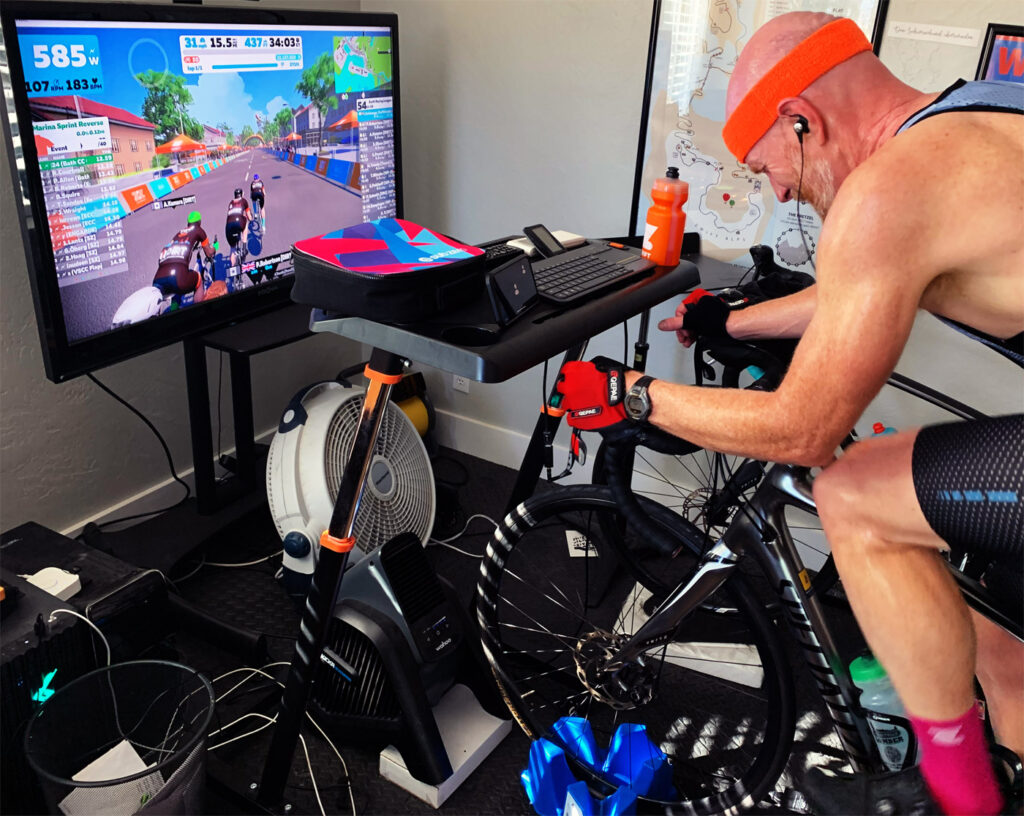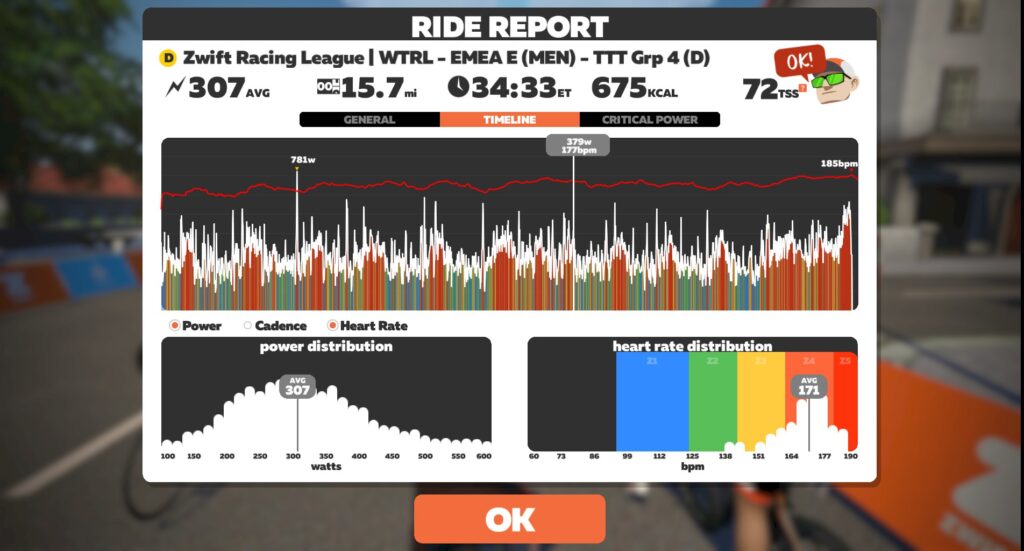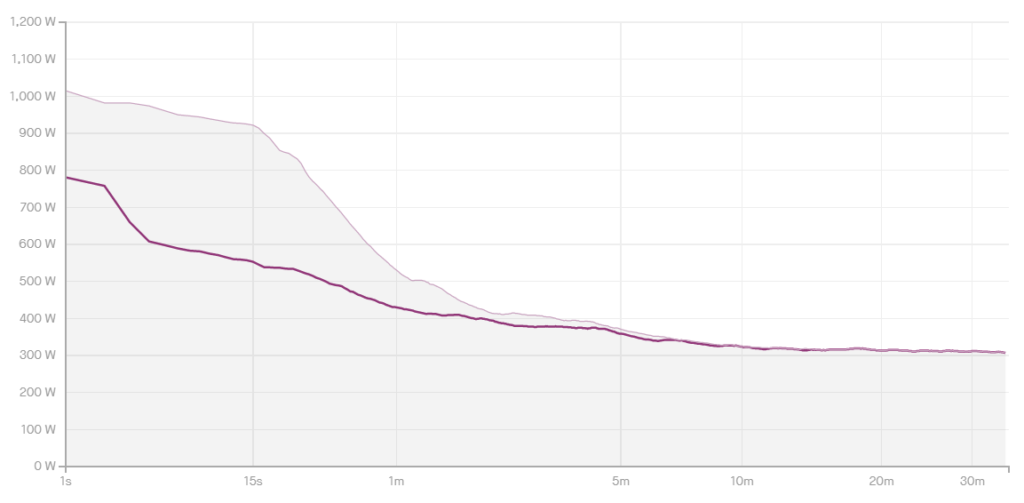This week was the second race of Zwift Racing League, and the first TTT of the series. My team, the DIRTy Beasts Hellhounds, had some TTT experience as individual riders on other teams – but we had never ridden a TTT together (with riders located in 5 different countries, finding time to practice has been a bit tough).
But we knew enough about TTT races to chat with some intelligence and formulate a solid race plan heading into Tuesday’s big event. One lap of France’s R.G.V. It was gonna hurt so good!
Warmup
I began my pre-race ritual the same as ever: chewed three pieces of caffeine gum, applied PR lotion on the legs, then suited up. I was on the trainer 45 minutes before the race began, and took my time warming up.
The Start
Because Zwift doesn’t have a built-in system for team time trialing, the folks at WTRL have set up a time-delay system which works surprisingly well:
- Each team is assigned a start time which is X minutes after the event actually begins
- You join the event start pens as you would any race, but when the clock hits 0, nobody goes!
- Each team designates a timer who begins their stopwatch as soon as the clock hits 0. When your time comes around, you go!
A bit hacky, yes. But here’s the amazing thing: this race set a new world record (to be confirmed by Guinness World Records) for the largest-ever team time trial, with 5,956 racers! Even with some hoops to jump through, racers want to race.
My team was the very last in our pen to go, so I joined the start pens a few minutes before the event began… then sat around for 13 minutes! Since you’ll be disqualified if you cross the start line early, most racers will open up the pairing screen (which stops your avatar from moving) and spin while they wait for their start time to come around. That’s what I did.
I was on a Zoom call with my six teammates, because one of them is located in UAE, where Discord doesn’t work properly. We chatted strategy and best practices as we waited for our time to come around, then our timer called it out: “1 minute to go!”
Stop pedaling. “30 seconds.” Close the pairing screen. Why is my heart rate already up? “10, 9, 8, 7, 6, 5, 3, 2, 1… go!”
We jumped out of the start pen, quickly getting up to speed and into formation.
Formation/Rotation Notes
We were using a formation suggested by one of our more experienced TTT riders. In this formation, we ride single-file (the most draft-efficient formation), but one strong rider stays at second position for the duration of the race. It’s his job to bring the group up to the front rider if a gap opens up, and when it’s the next rider’s turn to take a pull, they slingshot from behind the 2nd rider and into the front spot.
Basically, that second rider helps to anchor the group and keep things steady. That’s the theory, anyway. But would it work?

The Middle
Our initial formation and rotation were spectacular, considering the fact that our team had never ridden together in a TTT! We had agreed to take 30-second pulls, calling out our “stop time” over the comms each team we got to the front. So I’d rotate to the front and say, “I’m on until 4:30.” If we were feeling extra strong, we could stay on for 60 seconds – just make sure to call it out so everyone knew.
I was feeling good and took some 60-second pulls, but my rotations in and out of the front spot didn’t feel as smooth as they should be. I felt like I was accelerating too much off the front – but I didn’t want to take it easy and go slow, either! Then when my pull was done I would try to drift back, but kept getting stuck in the middle of the group.
Around 11 minutes in, Justin (our second wheel man) drifted off the back, then disappeared. Uh oh! “What happened to Justin?” “I’m not sure, but let’s just keep the rotation going.” No more fancy second wheel formation – now it was just a standard rotation. The best-laid plans of mice and men, right?
Heading into the first little effort of the R.G.V. route, the Aqueduc KOM, I was feeling great. I knew I had plenty more in the legs, but I also knew the last 5-10 minutes would be the toughest of the race. Climbing up the KOM we fell out of formation on purpose, simply blobbing up and hammering our way up the short climb, then reforming on the descent.
The Finish
Soon enough we found ourselves in the twisties near the end of the course. (I call them “Les Intestins” – because they’re twisty, and because the mixture of motion sickness and effort make my guts hurt!)
We had already agreed to just blob up and hammer through Les Intestins, since holding formation through all the turns and rollers would be a fool’s errand. If we were feeling weak we could sit behind a teammate, and if we felt strong we could go into the wind and push it.
I was feeling good, but my teammates were hammering through the twisties – I could hardly even get to the front! Eventually near the end I was able to get my nose into the wind… by that time, we had less than a minute left. I decided to just hammer all the way in, hoping to provide some draft for any struggling teammates and help us all get across the line just a bit faster. Head down, seated, high RPM – just going all in. It hurt! Monica snapped this shot of me in the final seconds:

Our official time was 34:28.375, for an average speed of 43.9kph (27.3mph). We had hoped to make it under 33 minutes, but knew that was a big ask. We’ll do better with practice, but my teammates and I seem to all agree that it’s a decent result for our first try.
Our time was good enough for third place in our current division (EMEA E Division B 6), so between that decent result and our first place result in last week’s race, we’ll probably be stuck in a fast division for the remainder of Season 1.
See my activity on Zwift.com >
See my ride on Strava >
See race results on ZwiftPower >
Watch the race recording
Start Time Controversy
There is some question/controversy regarding teams starting from different start pens. To put it simply: some of the teams we were competing against started in a pen which is further away from the finish line than our start pen. And it appears that WTRL starts their timing when you leave your pen, which means those teams are at a disadvantage of probably ~3 seconds.
Here’s what it looks like on the map:

Since this race was only a “qualifying heat” for division seeding, I’m not too concerned about this issue. I’m confident WTRL will figure it all out in fair fashion, and my guess is future TTTs will have competitors all starting from the same pens, to avoid this issue. (I’ve reached out to WTRL for comment, and will update this post if/when I hear back.)
Takeaways
TTT enthusiasts will tell you that it’s the best way to test your FTP, and they’re not wrong! Here’s what Strava showed for my power curve, comparing this race to my last 6 weeks:
Basically, this race updated my power curve starting at 9 minutes and going all the way to 34 minutes! Excellent.
My biggest takeaway from this race is that I’ve got a lot of room for improvement in the TTT. This is definitely a discipline where you can see a lot of improvement as you get to know your teammates better and work on rotation technique. It’s also a discipline that offers lots of options in terms of strategic choice. I’m confident my team will get smoother and faster with each race.

Your Comments
Did you race Tuesday’s TTT? How did it go for you? Share below!

